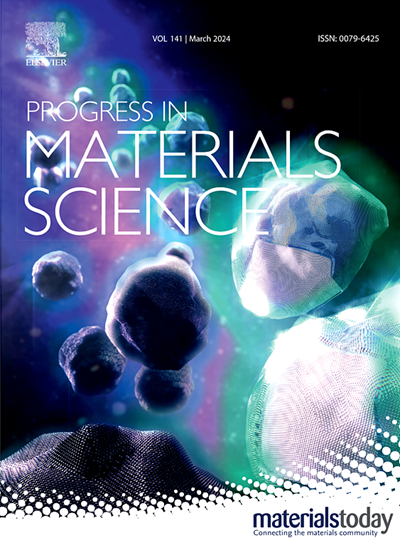电热活化软材料:机理、方法和应用
IF 33.6
1区 材料科学
Q1 MATERIALS SCIENCE, MULTIDISCIPLINARY
引用次数: 0
摘要
响应性软材料具有重量轻、柔韧性好、激活后变形大等独特优势,在航空航天工程、软机器人和人机交互等领域引起了广泛关注。通过集成工程电加热器实现的电热激活,因其按需加热的特性,正在成为基于响应式软材料的新型功能器件设计的一个新维度。然而,由于涉及多学科合作,需要从材料科学、应用物理学和先进制造等方面进行综合评估,因此精确控制这些设备的活化行为、性能协同和多功能集成仍具有挑战性。在此,我们从活化机制、电热活化下的独特性能和功能等方面概述了各种电热活化软材料,随后讨论了电加热设计和制造技术,最后展望了它们的应用前景。研究人员批判性地指出了电加热器设计、多物理场建模和集成制造方面的挑战。还介绍了基于电热活化软材料的设备的前景,包括多学科研究、概念突破和需求驱动型创新。本综述可为下一阶段的研究提供路线图,并有助于加快电热激活软材料的发展,使其走向实际应用。本文章由计算机程序翻译,如有差异,请以英文原文为准。
Electrothermally activated soft materials: Mechanisms, methods and applications
Responsive soft materials, with unique advantages of light weight, flexibility and large deformation upon activation, have attracted extensive attention in the fields of aerospace engineering, soft robots and human–computer interaction. Electrothermal activation, enabled by the integration of engineered electrical heaters, is emerging as a new dimension in the design of novel functionalities for devices based on responsive soft materials due to its on-demand heating. However, precise control of the activation behavior, performance synergy and multifunctional integration of these devices remain challenging as they involve multidisciplinary collaboration, requiring a comprehensive assessment from materials science, applied physics and advanced manufacturing. Here, we present an overview of various electrothermally activated soft materials in terms of activation mechanisms, unique performance and functionality under electrothermal activation, followed by a discussion of electrical heating design and fabrication techniques, and finally prospective applications of them. Challenges in electrical heater design, multi-physics modeling and integrated fabrication are critically identified. Perspectives for devices based on electrothermally activated soft materials are presented, including multidisciplinary research, conceptual breakthroughs and demand-driven innovations. This review could provide a roadmap for the next stage of research and contribute to accelerating the development of electrothermally activated soft materials towards real-world applications.
求助全文
通过发布文献求助,成功后即可免费获取论文全文。
去求助
来源期刊

Progress in Materials Science
工程技术-材料科学:综合
CiteScore
59.60
自引率
0.80%
发文量
101
审稿时长
11.4 months
期刊介绍:
Progress in Materials Science is a journal that publishes authoritative and critical reviews of recent advances in the science of materials. The focus of the journal is on the fundamental aspects of materials science, particularly those concerning microstructure and nanostructure and their relationship to properties. Emphasis is also placed on the thermodynamics, kinetics, mechanisms, and modeling of processes within materials, as well as the understanding of material properties in engineering and other applications.
The journal welcomes reviews from authors who are active leaders in the field of materials science and have a strong scientific track record. Materials of interest include metallic, ceramic, polymeric, biological, medical, and composite materials in all forms.
Manuscripts submitted to Progress in Materials Science are generally longer than those found in other research journals. While the focus is on invited reviews, interested authors may submit a proposal for consideration. Non-invited manuscripts are required to be preceded by the submission of a proposal. Authors publishing in Progress in Materials Science have the option to publish their research via subscription or open access. Open access publication requires the author or research funder to meet a publication fee (APC).
Abstracting and indexing services for Progress in Materials Science include Current Contents, Science Citation Index Expanded, Materials Science Citation Index, Chemical Abstracts, Engineering Index, INSPEC, and Scopus.
 求助内容:
求助内容: 应助结果提醒方式:
应助结果提醒方式:


